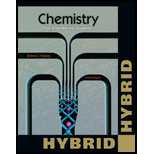
The rate of photodecomposition of the herbicide piclo- ram in aqueous systems was determined by exposure to sunlight for a number of days. One such experiment produced the following results. (Data from R.T. Hedlun and C.R. Youngson, “The Rates of Photodecomposition of Picloram in Aqueous Systems," Fate of Organic Pesticides in tbe Aquatic Environment, Advances in Chemistry Series, #111, American Chemical Society (1972), 159—172.)
| Exposure Time, t (days) | [Pidoram] |
(mol L_1)
Determine the order of reaction, the rate constant, and the half-life for the photodecomposition of picloram.
Interpretation:
To interpret the data collected and to determine the order of reaction, rate constant and the half-life for the photochemical decomposition of Picloram
Concept Introduction:
For a first order reaction:
And half-life is given by:
Where,
k = decay constant
t = time taken
Answer to Problem 11.49PAE
Solution:
The order of reaction:
First
The value of rate constant:
Half life of reaction:
Explanation of Solution
Given information:
Data collected for decomposition of Picloram is:
| Time, t (days) | [Picloram] (mol L-1) |
| 0 | 4.14 |
| 7 | 3.70 |
| 14 | 3.31 |
| 21 | 2.94 |
| 28 | 2.61 |
| 35 | 2.30 |
| 42 | 2.05 |
| 49 | 1.82 |
| 56 | 1.65 |
From the given data we will first calculate if the reaction is first order,
For the first order reaction, we will use the formula
Case 1)
When time (t) is 7 days
Substituting the values,
Case 2)
When time (t) is 14 days
Substituting the values,
The value of
The half-life of the reaction can be calculated with the help of formula
Substituting the value of k
Hence, the half-life is
The decomposition of Picloram is a first order reaction with rate constant
Want to see more full solutions like this?
Chapter 11 Solutions
Chemistry for Engineering Students, Hybrid Edition (with OWLv2 24-Months Printed Access Card)
- Define stability from both a kinetic and thermodynamic perspective. Give examples to show the differences in these concepts.arrow_forwardList at least four experimentally determined parameters that you, an experimenter, can define when exploring the hydrolysis of ethyl benzoate by aqueous sodium hydroxide.arrow_forwardThe acid-catalyzed iodination of acetone CH3COCH3(aq) + I2(aq) CH3COCH2I(aq) + HI(aq) is a common laboratory experiment used in general chemistry courses to teach the method of initial rates. The reaction is followed spectrophotometrically by the disappearance of the color of iodine in the solution. The following data (J. P. Birk and D. L Walters, Journal of Chemical Education, Vol. 69, p. 585, 1992) were collected at 23 C for this reaction. Determine the rate law for this reaction.arrow_forward
- Explain how a species might be part of a rate law but not part of a balanced chemical reaction.arrow_forwardThe hydrolysis of the sugar sucrose to the sugars glucose and fructose, C12H22O11+H2OC6H12O6+C6H12O6 follows a first-order rate equation for the disappearance of sucrose: Rate =k[C12H22O11] (The products of the reaction, glucose and fructose, have the same molecular formulas but differ in the arrangement of the atoms in their molecules.) (a) In neutral solution, k=2.11011s1 at 27 C and 8.51011s1 at 37 C. Determine the activation energy, the frequency factor, and the rate constant for this equation at 47 C (assuming the kinetics remain consistent with the Arrhenius equation at this temperature). (b) When a solution of sucrose with an initial concentration of 0.150 M reaches equilibrium, the concentration of sucrose is 1.65107M . How long will it take the solution to reach equilibrium at 27 C in the absence of a catalyst? Because the concentration of sucrose at equilibrium is so low, assume that the reaction is irreversible. (c) Why does assuming that the reaction is irreversible simplify the calculation in pan (b)?arrow_forwardWhat is the difference between the integrated and differential forms of the rate law?arrow_forward
- Rate data were obtained at 25 C for the following reaction. What is the rate-law expression for this reaction? A+2BC+2Darrow_forwardLabel the elementary processes for the reaction between H2 and O2 see section 20.7 as initiation, propagation, branching, or termination reactions.arrow_forwardExplain why half-lives are not normally used to describe reactions other than first order.arrow_forward
 Chemistry for Engineering StudentsChemistryISBN:9781337398909Author:Lawrence S. Brown, Tom HolmePublisher:Cengage Learning
Chemistry for Engineering StudentsChemistryISBN:9781337398909Author:Lawrence S. Brown, Tom HolmePublisher:Cengage Learning Principles of Modern ChemistryChemistryISBN:9781305079113Author:David W. Oxtoby, H. Pat Gillis, Laurie J. ButlerPublisher:Cengage Learning
Principles of Modern ChemistryChemistryISBN:9781305079113Author:David W. Oxtoby, H. Pat Gillis, Laurie J. ButlerPublisher:Cengage Learning Chemistry: The Molecular ScienceChemistryISBN:9781285199047Author:John W. Moore, Conrad L. StanitskiPublisher:Cengage Learning
Chemistry: The Molecular ScienceChemistryISBN:9781285199047Author:John W. Moore, Conrad L. StanitskiPublisher:Cengage Learning Chemistry by OpenStax (2015-05-04)ChemistryISBN:9781938168390Author:Klaus Theopold, Richard H Langley, Paul Flowers, William R. Robinson, Mark BlaserPublisher:OpenStax
Chemistry by OpenStax (2015-05-04)ChemistryISBN:9781938168390Author:Klaus Theopold, Richard H Langley, Paul Flowers, William R. Robinson, Mark BlaserPublisher:OpenStax Chemistry: Principles and PracticeChemistryISBN:9780534420123Author:Daniel L. Reger, Scott R. Goode, David W. Ball, Edward MercerPublisher:Cengage Learning
Chemistry: Principles and PracticeChemistryISBN:9780534420123Author:Daniel L. Reger, Scott R. Goode, David W. Ball, Edward MercerPublisher:Cengage Learning





